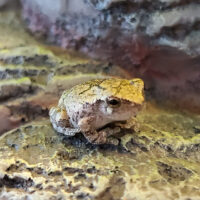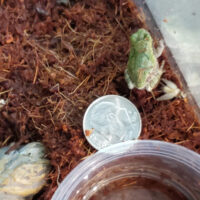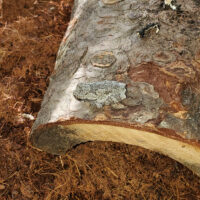 Purdue University - Extension - Forestry and Natural Resources
Purdue University - Extension - Forestry and Natural Resources
Got Nature? Blog
Question: About two months ago I found a tree frog in my parents backyard and was curious about the species of the frog. From what I can tell it appears to be a Gray Tree Frog however it is quite small. I’m not sure if it just happens to be a juvenile frog or if it is by chance a different species that I am mislabeling. Can you help with the identification of this small frog? It is about 3/4 in in length roughly the size of a dime. Coloration of the frog is Green/Gray depending on lighting and seemingly what the frog happens to be sitting on.
Answer: It is a juvenile Gray Treefrog. They can be as small as a fingernail or so.
Indiana is home to two species of Gray Treefrog–Cope’s Gray Treefrog (Hyla chrysoscelis) and Gray Treefrog, also referred to as Eastern Gray Treefrog in some references (Hyla versicolor). They are morphologically indistinguishable. The advertisement call of these Treefrogs is the only reliable characteristic for distinguishing the two species in the field. Both species have short, flute-like trills. The Cope’s Gray Treefrog’s call is louder, shriller, and faster and lasts approximately 2–3 seconds. The Gray Treefrog has a slower, more melodious trill lasting up to 4 seconds.
Gray treefrogs can change their color in response to temperature or to blend into their surroundings. Gray Treefrogs are common inhabitants of both upland and lowland deciduous hardwood forests as well as more developed areas. Gray Treefrogs are closely bound to their breeding ponds and do not typically travel far. They hibernate in or under logs, leaf litter, tree cavities, and rotting stumps.
Resources:
Sounds & Photos of Frogs and Toads in Indiana (shows Eastern Gray frog and Cope’s Gray frog), Purdue Extension-Forestry and Natural Resources web page
Frogs and Toads of Indiana, Purdue Extension-Forestry and Natural Resources publication
Orphaned & Injured Animals – Indiana Department of Natural Resources
Creating a Wildlife Habitat management Plan for Landowners, The Education Store, Purdue Extension resource center
Mythbusters, Got Nature? Blog, Purdue Extension – Forestry and Natural Resources
Appreciating Reptiles and Amphibians in Nature, The Education Store
Forestry Management for Reptiles and Amphibians: A Technical Guide for the Midwest, The Education Store
The Nature of Teaching, Unit 3: Reptiles, Amphibians, and the Scientific Method, The Education Store
Frogs and Toads of Indiana, The Education Store
Snakes and Lizards of Indiana, The Education Store
Ask the Expert: Turtles and Snakes video, Got Nature? post
Subscribe: Purdue Extension – Forestry and Natural Resources YouTube Channel, with over 195 videos regarding wildlife, forestry and natural resources
Brian MacGowan, Wildlife Extension Specialist
Purdue University, Department of Forestry and Natural Resources

Recent Posts
- Report Spotted Lanternfly – Purdue Landscape Report
Posted: April 10, 2024 in Alert, Forestry, Invasive Insects, Plants, Wildlife, Woodlands - Declining Pines of the White Variety – Purdue Landscape Report
Posted: in Alert, Disease, Forestry, Plants, Wildlife, Woodlands - Are you seeing nests of our state endangered swan? – Wild Bulletin
Posted: April 9, 2024 in Alert, Forestry, How To, Wildlife - Cicadas in Spring! – Purdue Landscape Report
Posted: in Forestry, Plants, Safety, Wildlife - New Deer Impact Toolbox
Posted: April 7, 2024 in Forestry, Land Use, Plants, Publication, Safety, Wildlife, Woodlands - 2024-25 Fishing Guide now available – Wild Bulletin
Posted: April 4, 2024 in Alert, Aquaculture/Fish, Aquatic/Aquaculture Resources, How To, Ponds, Wildlife - Help Research Chronic Wasting Disease – Wild Bulletin
Posted: April 3, 2024 in Disease, Forestry, How To, Safety, Wildlife, Woodlands - Indiana Reptiles and Amphibians – IFWOA Webinar
Posted: April 1, 2024 in Forestry, How To, Webinar, Wildlife, Woodlands - Birding through the Seasons – IFWOA Webinar
Posted: in Forestry, How To, Webinar, Wildlife, Woodlands - Look Out for Invasive Carp in Your Bait Bucket – Wild Bulletin
Posted: March 31, 2024 in Alert, Aquaculture/Fish, Aquatic/Aquaculture Resources, Invasive Animal Species, Wildlife
Archives
Categories
- Alert
- Aquaculture/Fish
- Aquatic/Aquaculture Resources
- Ask the Expert
- Christmas Trees
- Community Development
- Disease
- Drought
- Forestry
- Forests and Street Trees
- Gardening
- Got Nature for Kids
- Great Lakes
- How To
- Invasive Animal Species
- Invasive Insects
- Invasive Plant Species
- Land Use
- Natural Resource Planning
- Nature of Teaching
- Plants
- Podcasts
- Ponds
- Publication
- Safety
- Timber Marketing
- Uncategorized
- Urban Forestry
- Webinar
- Wildlife
- Wood Products/Manufacturing
- Woodland Management Moment
- Woodlands


